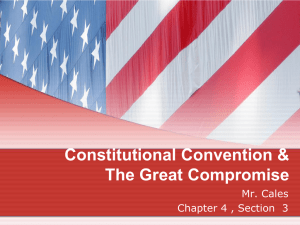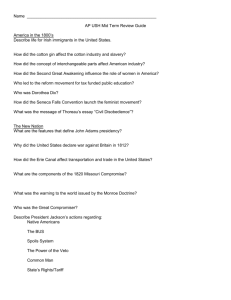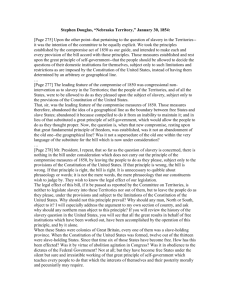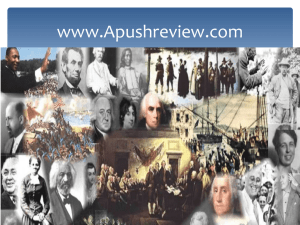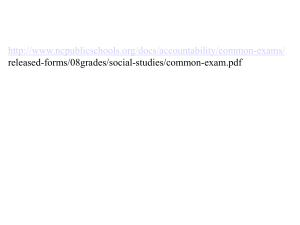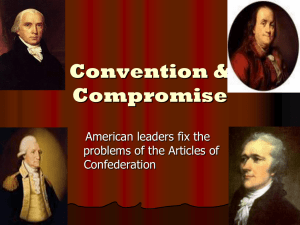Civil War Document Analysis Timeline Student
advertisement
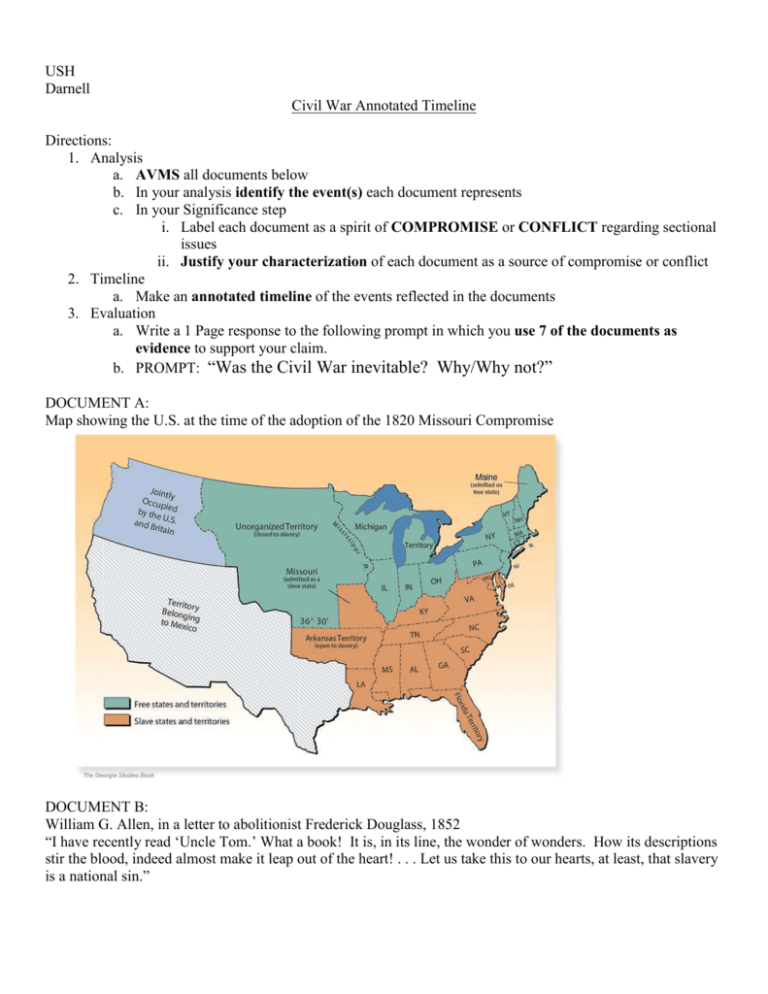
USH Darnell Civil War Annotated Timeline Directions: 1. Analysis a. AVMS all documents below b. In your analysis identify the event(s) each document represents c. In your Significance step i. Label each document as a spirit of COMPROMISE or CONFLICT regarding sectional issues ii. Justify your characterization of each document as a source of compromise or conflict 2. Timeline a. Make an annotated timeline of the events reflected in the documents 3. Evaluation a. Write a 1 Page response to the following prompt in which you use 7 of the documents as evidence to support your claim. b. PROMPT: “Was the Civil War inevitable? Why/Why not?” DOCUMENT A: Map showing the U.S. at the time of the adoption of the 1820 Missouri Compromise DOCUMENT B: William G. Allen, in a letter to abolitionist Frederick Douglass, 1852 “I have recently read ‘Uncle Tom.’ What a book! It is, in its line, the wonder of wonders. How its descriptions stir the blood, indeed almost make it leap out of the heart! . . . Let us take this to our hearts, at least, that slavery is a national sin.” DOCUMENT C: Map of the U.S. at time of the adoption of the Compromise of 1850 DOCUMENT D: Detroit Free Press, Detroit, Michigan 1854 “The bill for the organization of Nebraska, like the Compromise Measures, is common ground upon which all sections can meet. It forever sets at rest a mischievous question, and carries out great democratic doctrine of the right of the people of the incipient [new] States of the union to pass their own laws and make their own regulations.” DOCUMENT E: New York Herald-Tribune Headline, May 1856 James Townsley, Kansas Free-Soiler, 1856 "I joined the Pottawatomie Rifle Company at its re-organization, in May, 1856. At that time, John Brown, Jr., was elected Captain. . . John Brown first revealed to me the purpose of the expedition. He said it was to sweep the Pottawatomie of all Pro-slavery men living on it. He said, ‘We must fight fire with fire in order to strike terror into the hearts of the pro-slavery people.’” DOCUMENT F: Majority Opinion, written by Chief Justice Roger Taney in Dred Scott v Sandford, 1857 “The language of the Declaration of Independence is equally conclusive . . . “We hold these truths to be selfevident that all men are created equal; that they are endowed by their Creator with certain unalienable rights; that among them is life, liberty, and the pursuit of happiness; that to secure these rights, Governments are instituted, deriving their just powers from the consent of the governed.” The general words above quoted would seem to embrace the whole human family, and if they were used in a similar instrument at this day would be so understood. But, it is too clear for dispute, that the enslaved African race were not intended to be included, and formed no part of the people who framed and adopted this declaration.” DOCUMENT G: Second Senatorial Debate with Abraham Lincoln, Freeport, IL, August 27, 1858 “It matters not what way the Supreme Court may hereafter decide as to the abstract question whether slavery may or may not go into a Territory under the Constitution, the people have the lawful means to introduce it or exclude it as they please, for the reason that slavery cannot exist a day or an hour anywhere, unless it is supported by local police regulations. Those police regulations can only be established by the local legislature, and if the people are opposed to slavery they will elect representatives to that body who will by unfriendly legislation effectually prevent the introduction of it into their midst. If, on the contrary, they are for it, their legislation will favor its extension. Hence, no matter what the decision of the Supreme Court may be on that abstract question, still the right of the people to make a slave Territory or a free Territory is perfect and complete under the Nebraska bill.” --“The Freeport Doctrine”, Senator Stephen A. Douglas DOCUMENT H: Broadside Advertisement November, 4, 1859, Author Unknown DOCUMENT I: 1860 Presidential Election Results DOCUMENT J: South Carolina State Official Records, Ser. IV, vol. 1, p. 1 AN ORDINANCE to dissolve the union between the State of South Carolina and other States united with her under the compact entitled "The Constitution of the United States of America." We, the people of the State of South Carolina, in convention assembled, do declare and ordain, and it is hereby declared and ordained, That the ordinance adopted by us in convention on the twenty-third day of May, in the year of our Lord one thousand seven hundred and eighty-eight, whereby the Constitution of the United States of America was ratified, and also all acts and parts of acts of the General Assembly of this State ratifying amendments of the said Constitution, are hereby repealed; and that the union now subsisting between South Carolina and other States, under the name of the "United States of America," is hereby dissolved. Done at Charleston the twentieth day of December, in the year of our Lord one thousand eight hundred and sixty. DOCUMENT K: Fort Sumter in Confederate Hands, April 1861, Photographer Unknown

